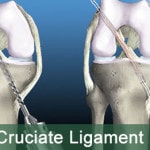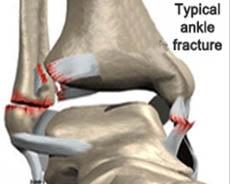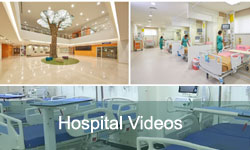Tag Archives: Benefits Anterior or Medial Cruciate Ligament (ACL) Surgery in India

Anterior or Medial Cruciate Ligament

Planning your medical trip to India is a very simple process with Joint Replacement Surgery Hospital India
- You just need to fill in our enquiry form and one of our executives will contact you soon.
- +91-9860432255 Call us at the given contact number for any assistance.
- Complete information regarding surgery is provided on our website.
Introduction
The Anterior or Medial Cruciate Ligament (ACL) is a cruciate ligament which is one of the four major ligaments of the human knee. In the quadruped stifle (analogous to the knee), based on itsanatomical position, it is referred to as the cranial cruciate ligament.
The ACL originates from deep within the notch of the distal femur. Its proximal fibers fan out along the medial wall of the lateral femoral condyle. There are two bundles of the ACL-the anteromedial and the posterolateral, named according to where the bundles insert into the tibial plateau. The ACL attaches in front of the intercondyloid eminence of the tibia, being blended with the anterior horn of the lateral meniscus. These attachments allow it to resist anterior translation and medial rotation of the tibia, in relation to the femur.
Anatomy-

The bone structure of the knee joint is formed by the femur, the tibia, and the patella. The ACL is one of the four main ligaments within the knee that connect the femur to the tibia.
The knee is essentially a hinged joint that is held together by the medial collateral (MCL), lateral collateral (LCL), anterior cruciate (ACL) and posterior cruciate (PCL) ligaments. The ACL runs diagonally in the middle of the knee, preventing the tibia from sliding out in front of the femur, as well as providing rotational stability to the knee.
The weight-bearing surface of the knee is covered by a layer of articular cartilage. On either side of the joint, between the cartilage surfaces of the femur and tibia, are the medial meniscus and lateral meniscus. The menisci act as shock absorbers and work with the cartilage to reduce the stresses between the tibia and the femur.
Check out the Patient Testimonial, where the patient shares about their success stories from treatments through Joint Replacement Surgery Hospital India.
Hi, I am Jennifer from the US. I came to India for ACL surgery through a leading surgery group in India. While playing basketball, I got an injury and after consulting it with my physio, he told me that I tore an ACL and needed to make an appointment with the specialist. After consultation, the specialist asked me to undergo some tests and after the arrival of the results he recommended me to undergo the ACL surgery. I was a bit apprehensive with the cost of surgery and therefore went online searching for an affordable treatment option. I found your surgery group in India and contacted them with my inquiry. They responded back and asked for my medical reports. After sending it, they mailed me with the best treatment plans. I gave them my confirmation and travelled to India. The hospital staff gave me a warm welcome. The surgeon was a kind person who cleared all my doubts before the surgery. The nurses were caring and compassionate. My surgery went well. I want to say a big thank you for the care and quality of service I received during my medical trip in India.
Causes-
This mostly happens amongst the sportsmen and this has lead to the invention of very successful operating techniques. The Anterior or Medial Cruciate Ligament or ACL are tough bands of tissue that connect the ends of bones together, located in the center of the knee and are stretched between the femur and the tibia. The main role of this ligament is to keep the tibia from advancing in relationship to the femurin position and rotation. A muscular compensation is only possible just to a certain limit. This instability by an ACL rupture can lead to consequence a risk of meniscuses and cartilage lesions.
Once ruptured it looses its mechanical qualities, even if the fragments are brought together and sutured. A natural tendon taken from the knee itself must be used and is known as ligamentoplasty.
Symptoms-
Though the symptoms following an ACL tear vary, swelling of the knee joint and a feeling of insecurity and instability of the knee when trying to change direction on the knees. Coming to a quick stop and difficulty in walking down a slope are the common other indications. Though the pain from the initial injury will usually be gone after two to four weeks, but the knee may still feel unstable.
Diagnosis-
Physical examination is the best way to diagnose a ruptured or deficient ACL. Though swelling is an indicator, aspirating or draining the fluid is another way to check. If blood is found when draining the knee, there is a greater chance of a torn ACL. A cartilage injury can also be indicative through this test.
Other methods that are used are the Lachman test, the pivot-shift test and the anterior drawer test. During these tests any excess motion or unexpected movement of the tibia relative to the femur is an indicator to ligament damage. An MRI is the most accurate way to diagnose a damaged or torn ACL.
Nonsurgical treatment-
In nonsurgical treatment, progressive physical therapy and rehabilitation can restore the knee to a condition close to its pre-injury state and educate the patient on how to prevent instability. This may be supplemented with the use of a hinged knee brace. However, many people who choose not to have surgery may experience secondary injury to the knee due to repetitive instability episodes.
Surgical treatment is usually advised in dealing with combined injuries (ACL tears in combination with other injuries in the knee). However, deciding against surgery is reasonable for select patients. Nonsurgical management of isolated ACL tears is likely to be successful or may be indicated in patients:
- With partial tears and no instability symptoms
- With complete tears and no symptoms of knee instability during low-demand sports who are willing to give up high-demand sports
- Who do light manual work or live sedentary lifestyles
- Whose growth plates are still open (children)
Surgical treatment-
Before any surgical treatment, the patient is usually sent to physical therapy. Patients who have a stiff, swollen knee lacking full range of motion at the time of ACL surgery may have significant problems regaining motion after surgery. It usually takes three or more weeks from the time of injury to achieve full range of motion. It is also recommended that some ligament injuries be braced and allowed to heal prior to ACL surgery.The patient, the surgeon, and the anesthesiologist select the anesthesia used for surgery. Patients may benefit from an anesthetic block of the nerves of the leg to decrease postoperative pain.
The surgery usually begins with an examination of the patient’s knee while the patient is relaxed due the effects of anesthesia. This final examination is used to verify that the ACL is torn and also to check for looseness of other knee ligaments that may need to be repaired during surgery or addressed postoperatively.
If the physical exam strongly suggests the ACL is torn, the selected tendon is harvested (for an autograft) or thawed (for an allograft) and the graft is prepared to the correct size for the patient. After the graft has been prepared, the surgeon places an arthroscope into the joint. Small (one-centimeter) incisions called portals are made in the front of the knee to insert the arthroscope and instruments and the surgeon examines the condition of the knee. Meniscus and cartilage injuries are trimmed or repaired and the torn ACL stump is then removed.
In the most common ACL reconstruction technique, bone tunnels are drilled into the tibia and the femur to place the ACL graft in almost the same position as the torn ACL. A long needle is then passed through the tunnel of the tibia, up through the femoral tunnel, and then out through the skin of the thigh. The sutures of the graft are placed through the eye of the needle and the graft is pulled into position up through the tibial tunnel and then up into the femoral tunnel. The graft is held under tension as it is fixed in place using interference screws, spiked washers, posts, or staples. The devices used to hold the graft in place are generally not removed.
Variations on this surgical technique include the “two-incision,” “over-the-top,” and “double-bundle” types of ACL reconstructions, which may be used because of the preference of the surgeon or special circumstances (revision ACL reconstruction, open growth plates).
Before the surgery is complete, the surgeon will probe the graft to make sure it has good tension, verify that the knee has full range of motion and perform tests such as the Lachman’s test to assess graft stability. The skin is closed and dressings (and perhaps a postoperative brace and cold therapy device, depending on surgeon preference) are applied. The patient will usually go home on the same day of the surgery.
Rehabilitation-
The goals for rehabilitation of ACL reconstruction include reducing knee swelling, maintaining mobility of the kneecap to prevent anterior knee pain problems, regaining full range of motion of the knee, as well as strengthening the quadriceps and hamstring muscles.
The patient may return to sports when there is no longer pain or swelling, when full knee range of motion has been achieved, and when muscle strength, endurance and functional use of the leg have been fully restored.
The patient’s sense of balance and control of the leg must also be restored through exercises designed to improve neuromuscular control.4 This usually takes four to six months. The use of a functional brace when returning to sports is ideally not needed after a successful ACL reconstruction, but some patients may feel a greater sense of security by wearing one.
Why Choose Joint Replacement Surgery Hospital India for Anterior or Medial Cruciate Ligament (ACL) Surgery?
Joint Replacement Surgery Hospital India offers highest quality bone and joint health care with attentiveness, care and compassion to meet the needs of the patients and their loved ones. The medical team includes board-certified orthopedic surgeons who are familiar with all the aspects of the musculoskeletal system. Our hospital uses the most advanced technologies available for the orthopaedic procedures and has a lower complication rate.
Since the ACL does not heal, the ligament needs to be replaced or reconstructed. We have an experienced surgical team and fully equipped operation theatre facility with excellent infrastructure for the post operative care and rehabilitation. The Anterior or Medial Cruciate Ligament Reconstruction (ACLR) Surgery helps restore the stability and function of the knee to allow return to your previous level of activity. The surgery for ACL uses an arthroscopically assisted technique which has proven to be quite effective.
If you are really seeking for Anterior or Medial Cruciate Ligament (ACL) Surgery, kindly fill up the form for a free consultation with our surgeons. You will be provided with thorough analysis and suggestions regarding the Anterior or Medial Cruciate Ligament (ACL) Surgery you are seeking .
Listen to the Voices of Our Happy Patients
Faq
The ACL is a ligament in the middle of the knee that connects the tibia (shinbone) to the fibia (thigh bone).
A key feature of a serious ACL injury is a feeling of instability (i.e. that the knee may collapse from underneath you).
Not always. Some people are able to function normally without surgery, so long as they have physiotherapy, but others need reconstructive surgery no matter how much physiotherapy they have. Whether or not you have your ACL reconstructed also depends on how active you are, and how your injury impacts on your daily and sporting activities.
Early surgical intervention to repair a torn ACL is not recommended in the vast majority of cases, and physiotherapy for at least four to six weeks is almost always recommended first in the amateur sportsperson. This approach has the advantage of allowing any other associated injuries to settle, and any inflammation to subside. Taking time to have physiotherapy also gives the patient and physiotherapist the opportunity to assess whether they feel there is a genuine need for reconstruction.
It is widely accepted that the best substitute for one’s own ACL is to use an autologous graft, which is a term used to describe another tissue, such as a ligament or tendon, taken from your own body. The autologous graft most usually used is that of the hamstrings. These are a large group of muscles in the back of the thigh that run from the hips down to the knees. The hamstrings most commonly used are that of semitendinosus and gracilis. Obviously, many other techniques exist, although the choice of graft will depend on your surgeon’s experience and familiarity with the preferred procedure.
Although you might initially feel a sense of weakness in your hamstring muscles, you can quite quickly regain almost full muscle power without a hamstring.
Many older people find that wearing a well fitted, ACL-specific knee brace gives them the confidence and stability to return to the sport they enjoyed previously without the need for surgery.
Any injury that involves the knee being twisted while the foot is planted on the ground can result in a serious ligament injury. Key features of a serious knee injury include a feeling of instability (i.e. a sense that the knee may collapse from underneath you). Recurrent episodes of the knee collapsing with associated swelling and pain are an obvious sign that all is not well, and that medical attention should be sought.
Compared with surgery for meniscal tears, ACL reconstruction is a much more involved procedure as it involves taking a tendon graft as indicated (usually the hamstring) from another part of the leg and using this to substitute the broken ligament. The time taken to recover from this type of surgery is much longer than for meniscal tears, and it may take up to nine months before you are able to undertake full sporting activities again. Generally, patients are advised that it can take up to one year to feel confident to participate in all their previous sporting activities, especially contact sports. When performed by an experienced surgeon, however, this type of surgery is highly successful, with 85–95% chance of patients experiencing good to excellent results.






